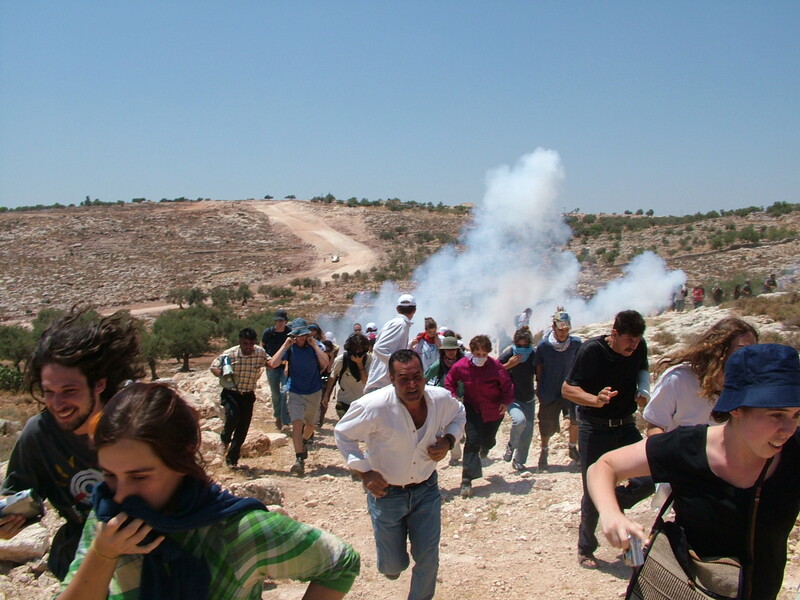Activism and BDS Beat 19 February 2012

Israeli soldiers fire on protestors in the West Bank village of Bilin.
Myar first experienced tear gas when she was one month old. Now she is seven. She has witnessed so much brutality in her short life that she has trouble sleeping at night.
Myar is the daughter of Iyad Burnat, a prominent campaigner against Israel’s wall in the West Bank village of Bilin. How does he explain to Myar the situation in which she is growing up? “Sometimes it’s difficult,” he told me. “She has a lot of questions, especially if she sees Israeli activists in our home, sitting and drinking tea. And at night Israeli soldiers with the same names are shooting at us.”
The story of Myar refutes the frankly racist notion propagated by some Western journalists that Palestinian children are conditioned to hate Jews. Israelis are welcome in her house, not as part of a “normalization” programme designed to sugar-coat the occupation with European or American money but as comrades in the struggle against injustice and apartheid.
Breaking the fear
Burnat was in Brussels yesterday, where he gave a brilliant presentation on unarmed resistance. He showed numerous photographs and video images of young Palestinians chaining themselves to fences and trees, knowing that they faced arrest. “These acts break the fear of the children and the people,” he said.
Ever since 2004, large numbers of local and international protesters have turned out every Friday in Bilin to protest at Israel’s attempts to suffocate the village. Bilin is hemmed in one side by the wall; on another by the settlement of Modi’in Illit, both of which are illegal under international law. The protests have continued despite Israel’s murder of Bassem and Jawaher Abu Rahmah in April 2009 and January 2011 respectively. Bassem was shot at close range with a tear gas canister; his sister Jawaher died from exposure to tear gas.
Laboratory for new weapons
Circumstantial evidence indicates that Bilin is being used as a laboratory to test new “crowd control” weapons in Israel’s arsenal. For the past few years, the village has been regularly sprayed by skunk water. Nobody is quite sure what this foul-smelling weapon contains; although samples have been brought to Birzeit University in the West Bank, scientists say that they would need to analyse it within an hour of its use to identify the chemicals involved. What is certain, though, is that it causes a severe itch when it comes in contact with human skin.
Burnat is part of a network of popular committees of struggle across the West Bank. He is encouraged by how 16 villages are now following Bilin’s example by holding frequent protests, the latest being Kfar Qaddoum near Nablus and Kafr ad-Dik near Qalqiya.
In April, a conference on undertaking a “global intifada” will be held in Bilin. Burnat believes that the growing boycott, divestment and sanctions (BDS) movement has illustrated how “we can all take actions against Israel; the occupation is everywhere not just in Palestine.”
NYT’s flimsy knowledge of Gandhi
Surfing the internet after my conversation with Burnat, I learned that the latest demonstration in Bilin saluted the bravery of hunger striker Khader Adnan. And I was reminded of a 2010 opinion piece by Nicholas Kristof in The New York Times, who contended that the tactics used in Bilin are a “far cry from the heroism of Gandhi’s followers.” Kristof argued that occasional stone throwing against one of the world’s most lethal armies means that Bilin’s protests do not constitute “non-violent resistance.”
Kristof seems to have a flimsy knowledge of Mahatma Gandhi’s teachings. If he had bothered to do a bit of background research, he would know that Gandhi argued that injustice must be opposed and that it is better to fight an aggressor with arms than to run away. As Linah Alsaafin has written for this website, the throwing of a rock cannot seriously be viewed as an act of violence if its target is firing bullets at a civilian population.
Make no mistake, the spirit of Gandhi is alive in Palestine, especially on Friday afternoons in Bilin.






Comments
turning the other cheek
Permalink michael hall replied on
But how more effective would it be if bullets were not met by rocks but by flowers?
Agreed, but young people take
Permalink R Lundquist replied on
Agreed, but young people take action--such injustice causes action. Had I grown up in Palestine, I would have joined Hamas as a teenager, and not just the political wing. Humans act when they experience hatred and injustice--young people have not the maturity to see that Ghandi's is the only way, absent superior force and numbers.
Not effective at all, flowers
Permalink Oliver replied on
Not effective at all, flowers are not bullet proof
alterations
Permalink michael hall replied on
your missing the metaphoric point-bullets are not bullet proof either...violence in answer to violence means that violence wins...resist not evil by feeding it...victory is within the one who refuses to use the same tools as the foe,to match hate with love,to reflect a sneer with a smile...that is change...
we were all 'young' and
Permalink michael hall replied on
we were all 'young' and inexperienced...hence we are taught..and by what we are taught,grasp,understand it is our lot to teach...hate feeds hate...violence feeds violence...anger met with violence does not change but grows into more negativity...this is how we will change the world by changing ourselves and becoming what we wish to be...
don't justify bullets - for ANY reason
Permalink Chuck Johnson replied on
The point Mr. Abunimah is making is that the Gandhi-led struggle in India was a lot messier than it is portrayed in today's media. Kristof should be ashamed of himself for not doing a better job of researching his own assertions. Yes, it is better p.r. not to have rocks thrown, but it is a minor offense compared to bullets - even rubber-coated ones.